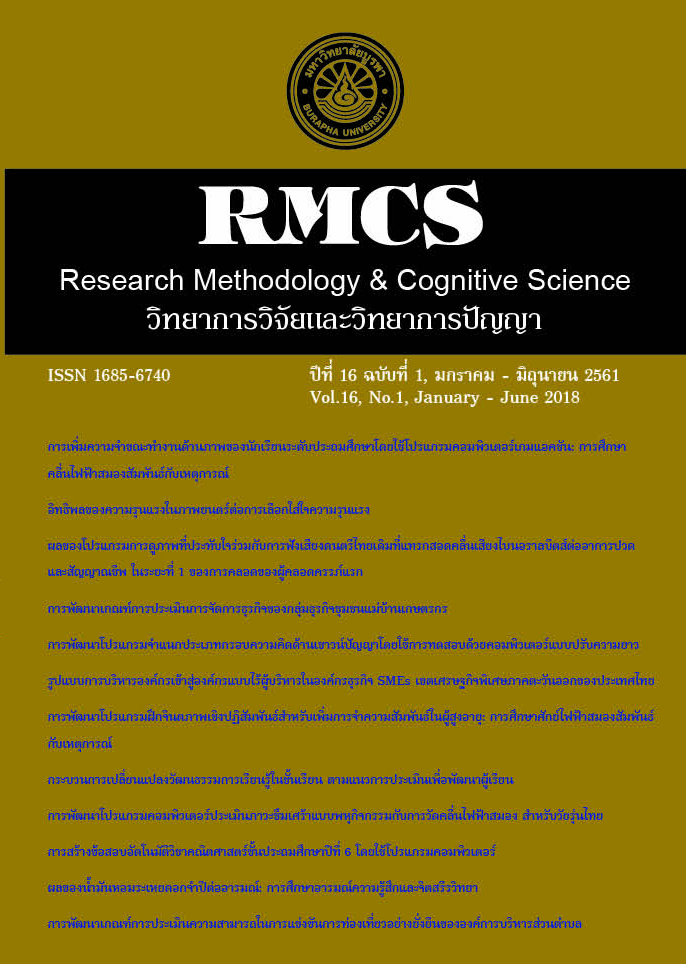Automatic Item Generation in Mathematics for Grade Six Students Using Computer Software
Main Article Content
Abstract
The objectives of this research were 1) to construct grade six Mathematics item models, 2) to develop computer software for the automatic generation of Grade six Mathematics test items, and 3) to study the relationship between test results obtained from the prototype test, and those obtained by a test automatically generated by the software. The research was divided into three phases as follows: 1) Construction of an O-NET examination in Mathematics using item models
based on automatic item generation (AIG) principle; 2) Development of computer software for the automatic generation of Grade six Mathematics items; and 3) determination of the relationship between the test scores obtained from the prototype test and the test constructed by using the software developed for the study. The sample involved 30 students who had completed Grade six. Data were analyzed using Pearson’s Correlation Coefficient.
The results were as follows:
1. Forty four prototype test items were generated by using O-NET examinations from the academic year 2008 to 2010, with item quality analyzed by applying the three-parameter logistic model from Item Response Theory (IRT).
2. The test created by the computer software developed for the study was made available at http://www.aigtest.com, and was judged to be highly suitable for grade six students.
3. The test created from the computer software was positively correlated with the prototype test, r=.96, significant at the .01 level.
Article Details
References
พิชิตพล ถนอมงาม. (2547). การพัฒนาโปรแกรมคอมพิวเตอร์สำหรับสร้างข้อสอบวัดความสามารถด้านการคำนวณช่วงชั้นที่ 3 (ชั้นมัธยมศึกษาปีที่ 1-3). วารสารวิจัยและวัดผล
การศึกษา มหาวิทยาลัยบูรพา, 2(1), 73-92.
สถาบันทดสอบทางการศึกษาแห่งชาติ (องค์การมหาชน) สทศ. (2558). ค่าสถิติพื้นฐาน O-NET ปีการศึกษา 2558.วันที่ค้นข้อมูล 26 มีนาคม 2559, เข้าถึงได้จาก http://www.onetresult.niets.or.th/AnnouncementWeb/PDF/SummaryONETP6_2558.pdf
สมพิศ กาญจนาเพ็ญกุล. (2556). การสร้างข้อสอบคู่ขนานอิงโดเมนโดยใช้รูปแบบฟาเซท วิชาคณิตศาสตร์เรื่องวงกลม ชั้นมัธยมศึกษาปีที่ 3. วารสารวิชาการศรีปทุม ชลบุรี, 9(4), 56-60.
อรยา ปรีชาพานิช. (2557). คู่มือเรียนการวิเคราะห์และออกแบบระบบ (System Analysis and Design) ฉบับสมบูรณ์. นนทบุรี: ไอดีซี พรีเมียร์.
เอื้อมพร หลินเจริญ, สิริศักดิ์ อาจวิชัย และภีรดา จันทร์อินทร์. (2552). รายงานวิจัย: ปัจจัยเชิงสาเหตุที่ทำให้คะแนนการทดสอบ O-NET ของนักเรียนชั้นประถมศึกษาปีที่ 6 และชั้นมัธยมศึกษาปีที่ 6 ต่ำ.กรุงเทพฯ: สถาบันทดสอบทางการศึกษาแห่งชาติ (องค์การมหาชน).
Gierl, M. J., & Haladyna, T. M. (2013). Automatic Item Generation: Theory and Practice. New York: Routledge.
Gierl, M. J., Zhou, J., & Alves, C. (2008). Developing a taxonomy of item model types to promote assessment engineering. The Journal of Technology, Learning, and assessment, 7(2), 4-24. Retrieved 31 March 2016 from http://www.jtla.org.
Muninsakorna, Y., Tinnaworn, P., & Sukhanonsawata, S. (2015). Development of the Computerized Adaptive Testing Program for O-NET at the Grade 6 Level. In Proceedings of the Burapha University International Conference 2015, (pp. 290-298). Chon Buri: Burapha University.

